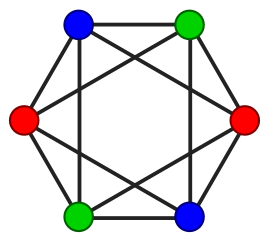Coloring & Connectivity
The graph coloring problem requires that we color the adjacent vertices with different colors, and use as few different colors as possible.
An example graph with

A graph
The minimum value of
It is a challenging problem, to say the least.
The chromatic number of a cycle that has even-numbered vertices is
An odd-length cycle requires
A complete graph
A bipartite graph
A graph
A graph with maximum degree at most
The maximum degree is the largest vertex degree in a graph. In our example, it is 4. So, our graph is 5-colorable.
That is, if every vertex has at most
A graph is connected when every pair of its vertices are connected.
A subgraph is exactly what you might think it is;
A connected component of a graph is a subgraph that has some vertex and everything that is connected to it.
So,
The connection strength is measured by the number of links that fail before connectedness fails.
What does it mean?
Vertices
In other words,
You can remove any amount of edges up to
Need more definitions? Here is another one:
Two vertices are
when it takes at least “edge-failures” to disconnect them.
For example, a complete graph,
Every cycle is
If two vertices are connected in a graph
, but not connected when an edge is removed, then is called a cut edge of .